Experimental Study of Fog and Suspended Water Effects on the 5G Millimeter Wave Communication Channel
Abstract
1. Introduction
2. Atmospheric mmW Propagation in the Presence of Water Suspension
3. Millimeter Wave Link Budget
4. Experimental Setup
5. Visibility Measurement and Estimation of Water Droplet Concentration
6. Experimental Results
6.1. Attenuation
6.2. Phase Shift and Group Delay
7. Summary and Conclusions
Author Contributions
Funding
Conflicts of Interest
Appendix A
| Symbol | Meaning | Symbol | Meaning |
|---|---|---|---|
| GHz | Giga-Hertz | time delay in vacuum | |
| m | meter | incremental group delay | |
| km | kilometer | c | Light speed |
| cm | centimeter | H2O | water |
| µm | micrometer | O2 | oxygen |
| nm | nanometer | Pr and Pt | received and transmitted power respectively |
| gr | gram (unit of mass) | Gr and Gt | the gains’ of the receiving and transmitting antennas |
| ps | pico-second | mmW | millimeter wave |
| size parameter | averaged mass extinction coefficient (in ) | ||
| Pi ( = 3.14159) | W | water droplet concentration | |
| D | droplet diameter | concentration of the liquid water phase (in ) | |
| wavelength | and | the intensity signals measured at time zero when the tunnel is clean and at a time ‘t’ | |
| refractive index (frequency dependent) | instantaneous visibility | ||
| real constant of nondispersive term | extinction efficiency | ||
| real terms respectively | actual size distribution | ||
| imaginary terms respectively | water density | ||
| α(f) | attenuation propagation factors | Sig and Ref | indexes of abbreviations for the APDs types |
| β(f) | wavenumber propagation factors | water concentration due to a vapor phase | |
| d | propagation distance | S21 | measuring scattering parameter |
| attenuation | dB | decibel | |
| corresponsive phase shift | dBm | decibel relative to milli-wate | |
| phase shift in vacuum | °C | temperature in callus degrees | |
| incremental phase shift | kPa | Kilopascals (Atmospheric pressure unit) | |
| group delay | RH | Relative humidity |
References
- Federal Communications Commission. Fact Sheet: Spectrum Frontiers Proposal To Identify, Open Up Vast Amounts Of New High-Band Spectrum For Next Generation (5G) Wireless Broadband. 2017. Available online: https://transition.fcc.gov/Daily_Releases/Daily_Business/2016/db0623/DOC-339990A1.pdf (accessed on 23 June 2016).
- Rappaport, T.S.; Xing, Y.; MacCartney, G.R.; Molisch, A.F.; Mellios, E.; Zhang, J. Overview of Millimeter Wave Communications for Fifth-Generation (5G) Wireless Networks—With a Focus on Propagation Models. IEEE Trans. Antennas Propag. 2017, 65, 6213–6230. [Google Scholar] [CrossRef]
- Rappaport, T.S.; Heath, R.W., Jr.; Daniels, R.C.; Murdock, J.N. Millimeter Wave Wireless Communications; New York University Prentice Hall: New York, NY, USA, 2015. [Google Scholar]
- Feng, W.; Li, Y.; Jin, D.; Su, L.; Chen, S. Millimetre-Wave Backhaul for 5G Networks: Challenges and Solutions. Sensors 2016, 16, 892. [Google Scholar] [CrossRef]
- Ducournau, G.; Szriftgiser, P.; Pavanello, F.; Peytavit, E.; Zaknoune, M.; Bacquet, D.; Beck, A.; Akalin, T.; Lampin, J.F. THz Communications Using Photonics and Electronic Devices: The Race to Data-Rate. J. Infrared Milli. Terahz. Waves 2015, 36, 198–220. [Google Scholar] [CrossRef]
- Matricciani, E. A Relationship Between Phase Delay and Attenuation Due to Rain and Its Applications to Satellite and Deep-Space Tracking. IEEE Trans. Antennas Propag. 2009, 57, 3602–3611. [Google Scholar] [CrossRef]
- Federici, J.; Moeller, L. Review of Terahertz and Subterahertz Wireless Communications. J. Appl. Phys. 2010, 107, 111101. [Google Scholar] [CrossRef]
- Moeller, L.; Su, K.; Barat, R.B.; Federici, J.F. THz and IR Signaling through Fog Scintillations. In Proceedings of the European Wireless 2012—18th European Conference 2012, Poznan, Poland, 18–20 April 2012. [Google Scholar]
- Boccardi, F.; Heath, R.W.; Lozano, A.; Marzetta, T.L.; Popovski, P. Five Disruptive Technology Directions for 5G. IEEE Commun. Mag. 2014, 52, 74–80. [Google Scholar] [CrossRef]
- Ge, X.; Tu, S.; Mao, G.; Wang, C.X.; Han, T. 5G Ultra-Dense Cellular Networks. IEEE Wirel. Commun. 2016, 23, 72–79. [Google Scholar] [CrossRef]
- Chen, S.; Zhao, J. The Requirements, Challenges, and Technologies for 5G of Terrestrial Mobile Telecommunication. IEEE Commun. Mag. 2014, 52, 36–43. [Google Scholar] [CrossRef]
- Csurgai-Horváth, L.; Bitó, J. Fog Attenuation on V Band Terrestrial Radio and a Low-Cost Measurement Setup. In Proceedings of the Future Network & Mobile Summit, Florence, Italy, 16–18 June 2010. [Google Scholar]
- Vasseur, H.; Gibbins, C.J. Inference of Fog Characteristics from Attenuation Measurements at Millimeter and Optical Wavelength. Radio Sci. 1996, 31, 1089–1097. [Google Scholar] [CrossRef]
- Antes, J.; Boes, F.; Messinger, T.; Lewark, U.J.; Mahler, T.; Tessmann, A.; Henneberger, R.; Zwick, T.; Kallfass, I. Multi-Gigabit Millimeter-Wave Wireless Communication in Realistic Transmission Environments. IEEE Trans. Terahertz Sci. Technol. 2015, 5, 1078–1087. [Google Scholar] [CrossRef]
- Golovachev, Y.; Etinger, A.; Pinhasi, G.A.; Pinhasi, Y. Millimeter Wave High Resolution Radar Accuracy in Fog Conditions—Theory and Experimental Verification. Sensors 2018, 18, 2148. [Google Scholar] [CrossRef]
- Golovachev, Y.; Etinger, A.; Pinhasi, G.A.; Pinhasi, Y. Propagation Properties of Sub-Millimeter Waves in Foggy Conditions. J. Appl. Phys. 2019, 125, 151612. [Google Scholar] [CrossRef]
- Etinger, A.; Golovachev, Y.; Pinhasi, G.A.; Pinhasi, Y. Dielectric Characterization of Fog in the Terahertz Regime. Acta Phys. Pol. A 2019, 136, 749–753. [Google Scholar] [CrossRef]
- Battaglia, A.; Ajewole, M.O.; Simmer, C. Multiple Scattering Effects due to Hydrometeors on Precipitation Radar Systems: Multiple Scattering Effects. Geophys. Res. Lett. 2005, 32. [Google Scholar] [CrossRef]
- Delanoë, J.; Protat, A.; Vinson, J.P.; Brett, W.; Caudoux, C.; Bertrand, F.; Hallali, R.; Barthes, L.; Haeffelin, M.; Dupont, J.C.; et al. BASTA: A 95-GHz FMCW Doppler Radar for Cloud and Fog Studies. J. Atmos. Ocean. Technol. 2016, 33, 1023–1038. [Google Scholar] [CrossRef]
- Matrosov, S.Y. Attenuation-Based Estimates of Rainfall Rates Aloft with Vertically Pointing Ka-Band Radars. J. Atmos. Ocean. Technol. 2005, 22, 43–54. [Google Scholar] [CrossRef]
- Matrosov, S.Y. Synergetic Use of Millimeter- and Centimeter-Wavelength Radars For retrievals of Cloud and Rainfall Parameters. Atmos. Chem. Phys. 2010, 10, 3321–3331. [Google Scholar] [CrossRef]
- Petty, G.M. A First Course in Atmospheric Radiation; University of Michigan Sundog: Ann Arbor, MI, USA, 2006. [Google Scholar]
- Shoshanim, O.; Peri, D.; Egert, S. High Resolution Spectroscopic Study in the Terahertz. IEEE Sens. J. 2014, 14, 547–553. [Google Scholar] [CrossRef]
- Liebe, H. Atmospheric EHF Window Transparencies Near 35, 90, 140 and 220 GHz. IEEE Trans. Antennas Propag. 1983, 31, 127–135. [Google Scholar] [CrossRef]
- Liebe, H.J. MPM—An Atmospheric Millimeter-Wave Propagation Model. Int. J. Infrared Milli. Waves 1989, 10, 631–650. [Google Scholar] [CrossRef]
- International Electronical Commission. International Lighting Vocabulary; CIE 17.4; International Electronical Commission: Geneva, Switzerland, 1987. [Google Scholar]
- International Telecommunication Union. Attenuation Due to Clouds and Fog; ITU-R P.840-8; International Telecommunication Union: Geneva, Switzerland, 2019. [Google Scholar]
- Pinhasi, G.A.; Golovachev, Y. Propagation of Linear FM Signals in Dielectric Media. ResearchGate. 2017. Available online: https://www.researchgate.net/publication/326176854_PROPAGATION_OF_LINEAR_FM_SIGNALS_IN_DIELECTRIC_MEDIA (accessed on 30 January 2020).
- Muhammad, S.S.; Flecker, B.; Leitgeb, E.; Gebhart, M. Characterization of Fog Attenuation in Terrestrial Free Space Links. Opt. Eng. Opt Eng 2007, 46. [Google Scholar] [CrossRef]
- Tampieri, F.; Tomasi, C. Size Distribution Models of Fog and Cloud Droplets in Terms of the Modified Gamma Function. Tellus 1976, 28, 333–347. [Google Scholar] [CrossRef][Green Version]
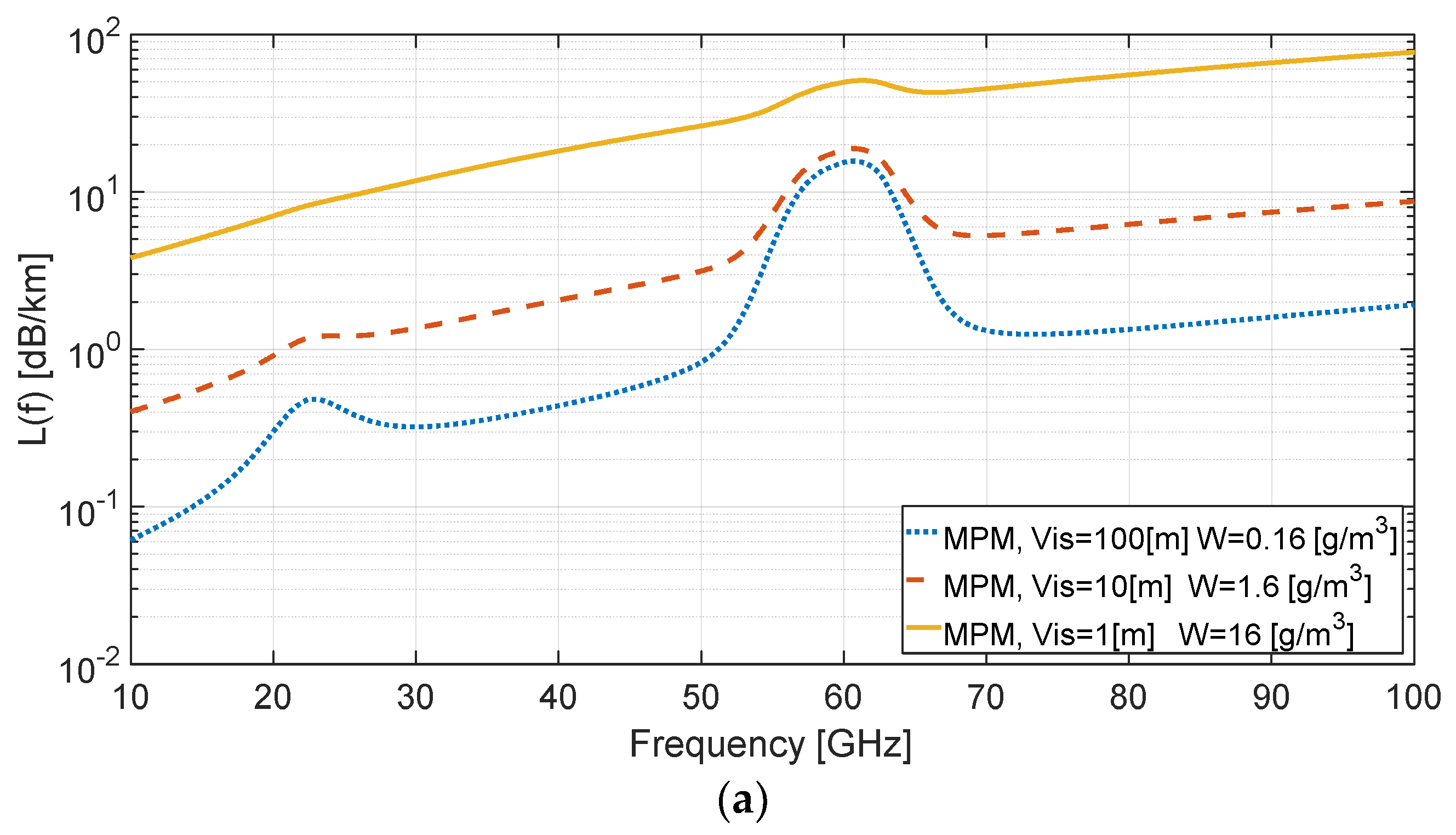
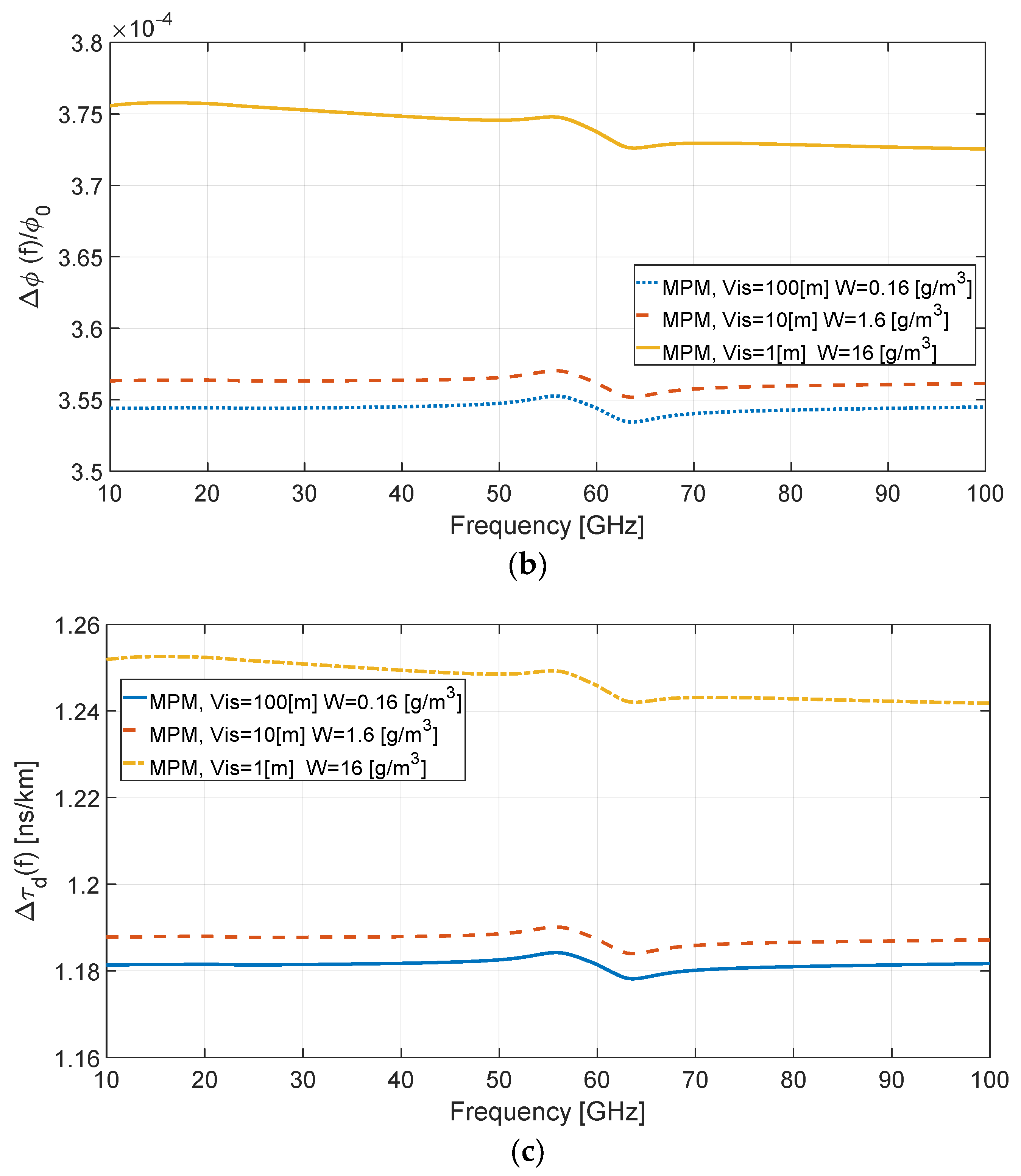
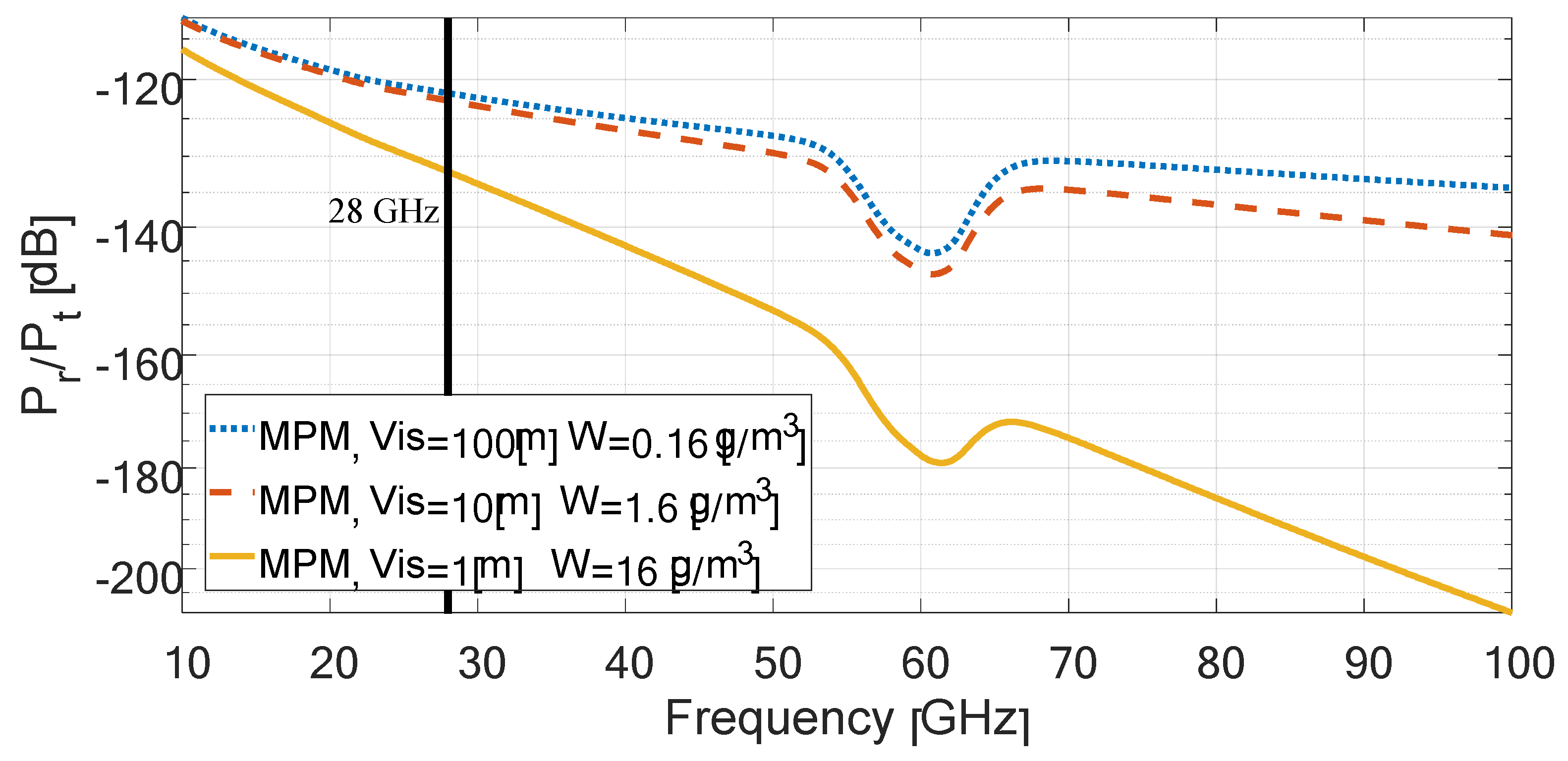

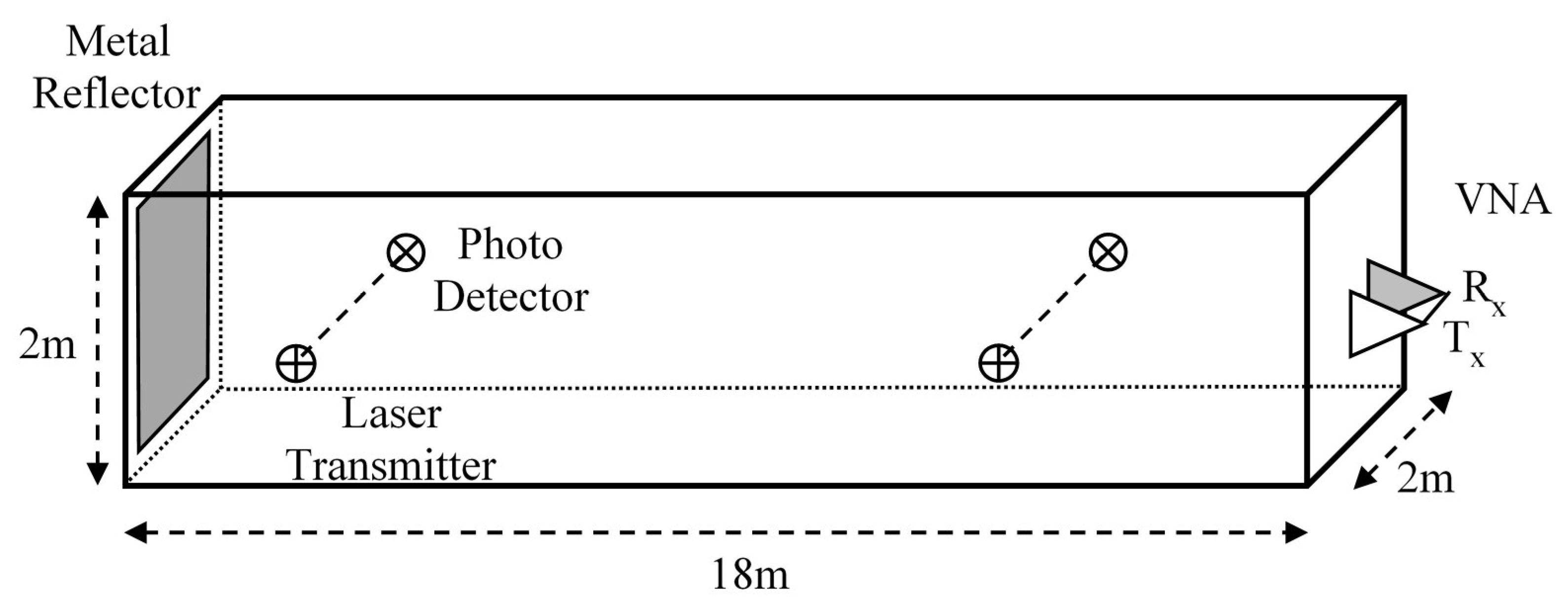

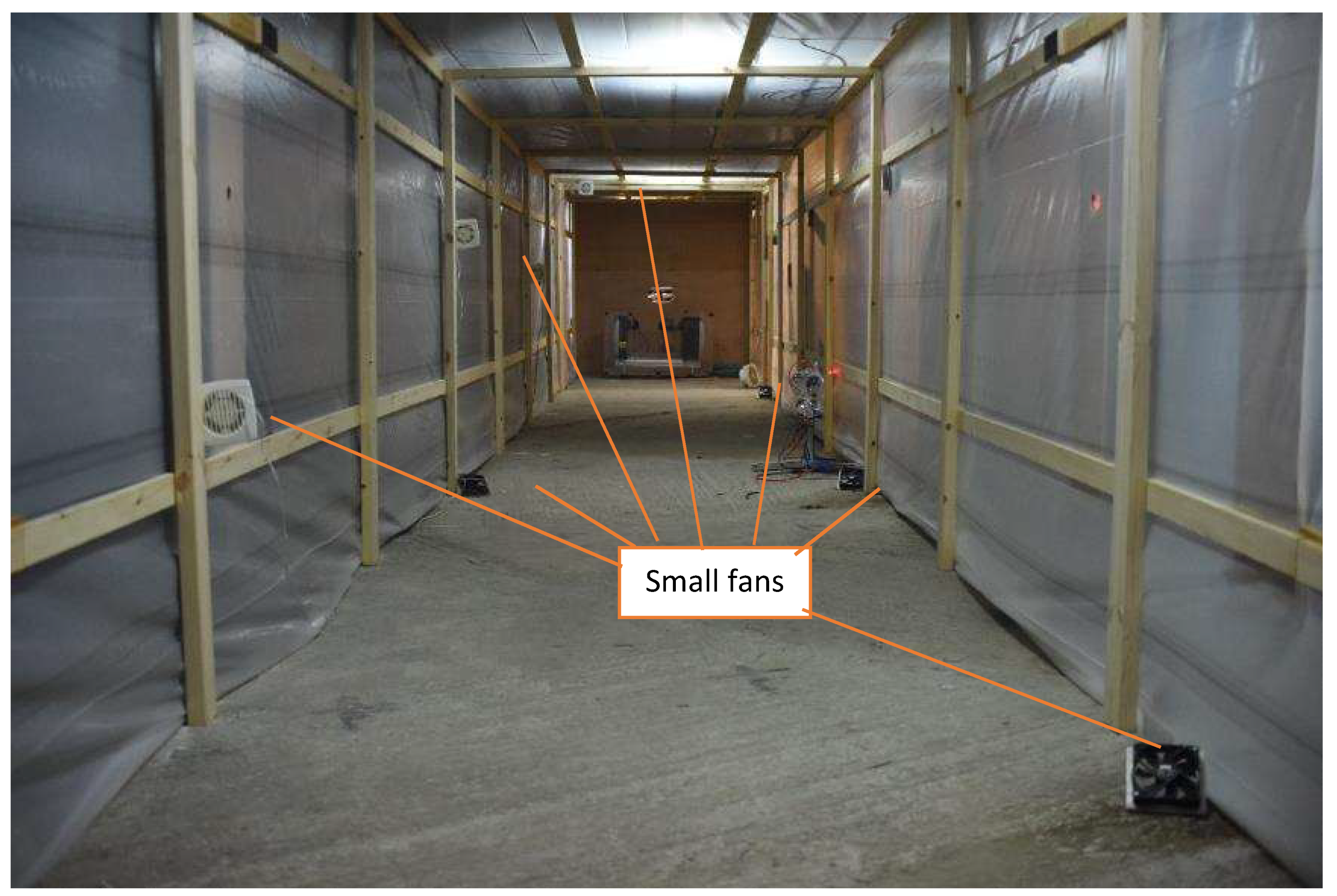
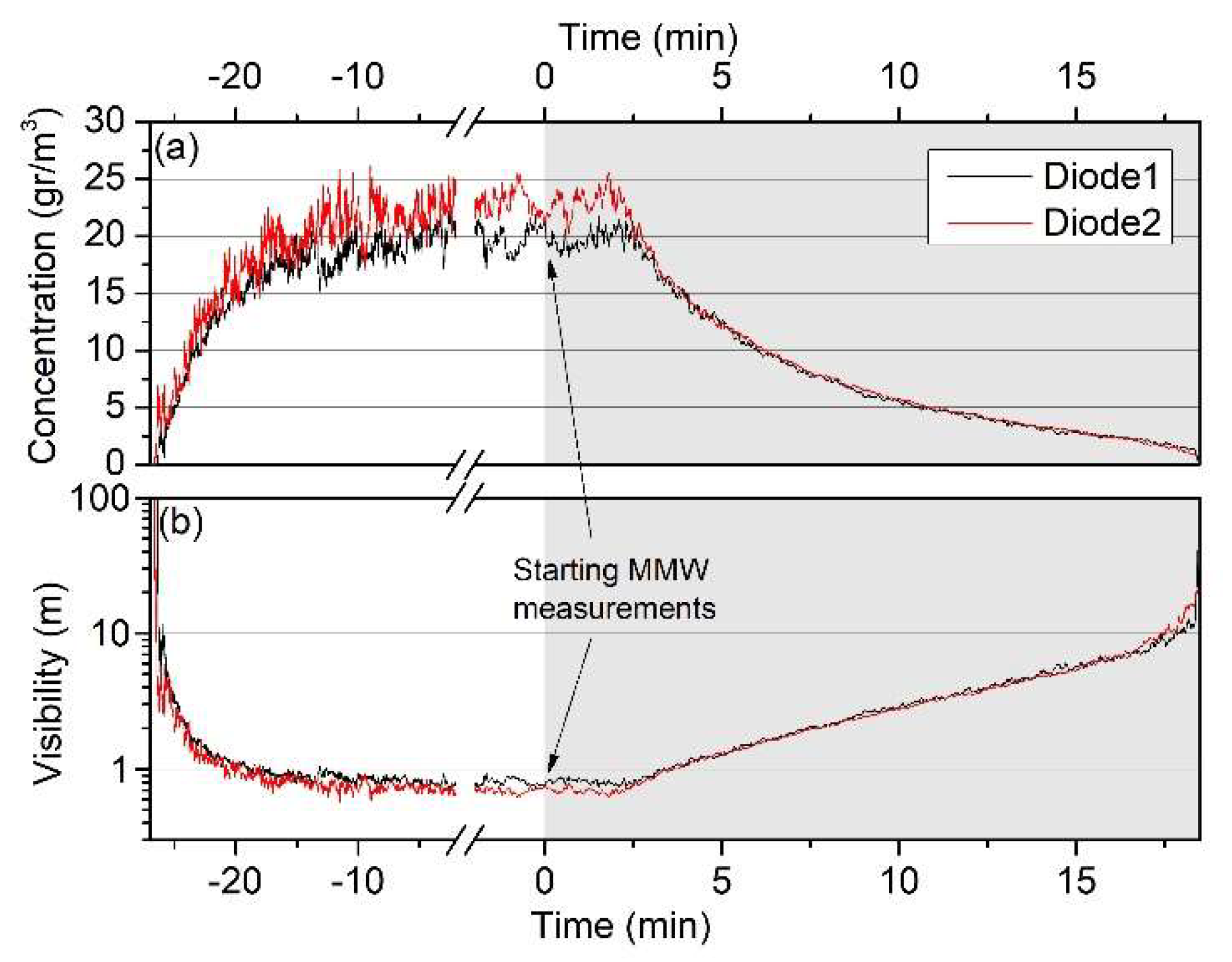
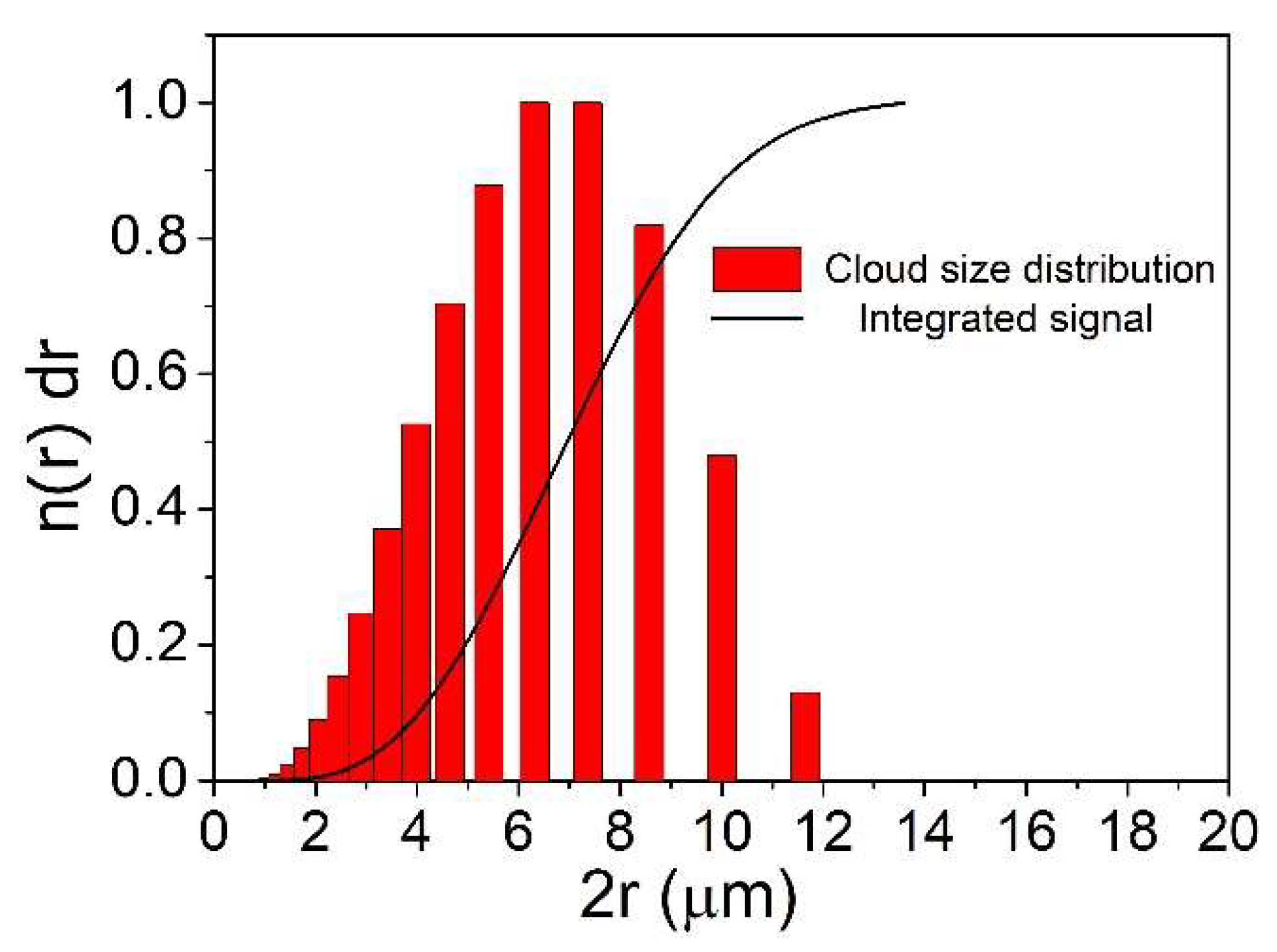



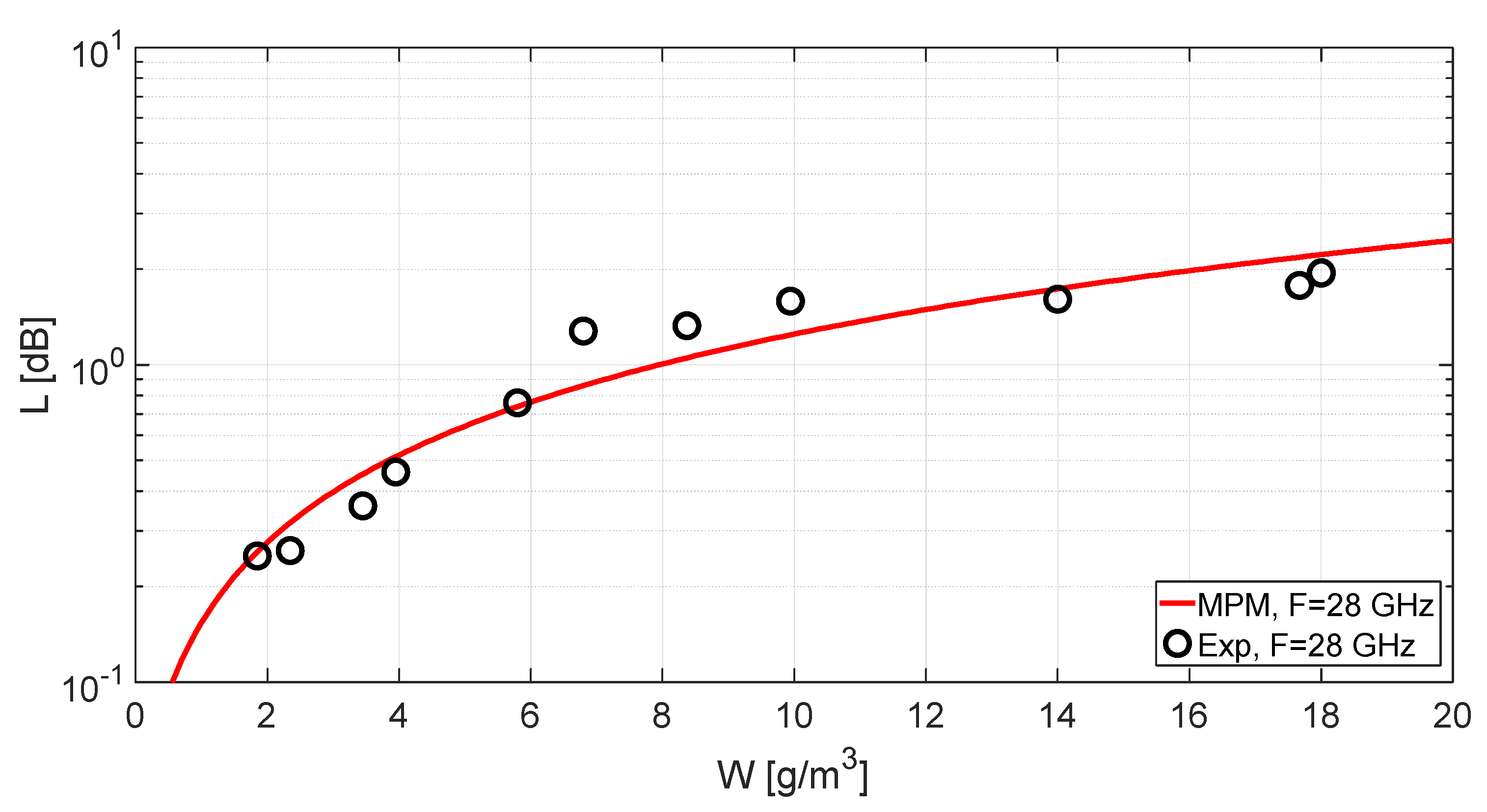

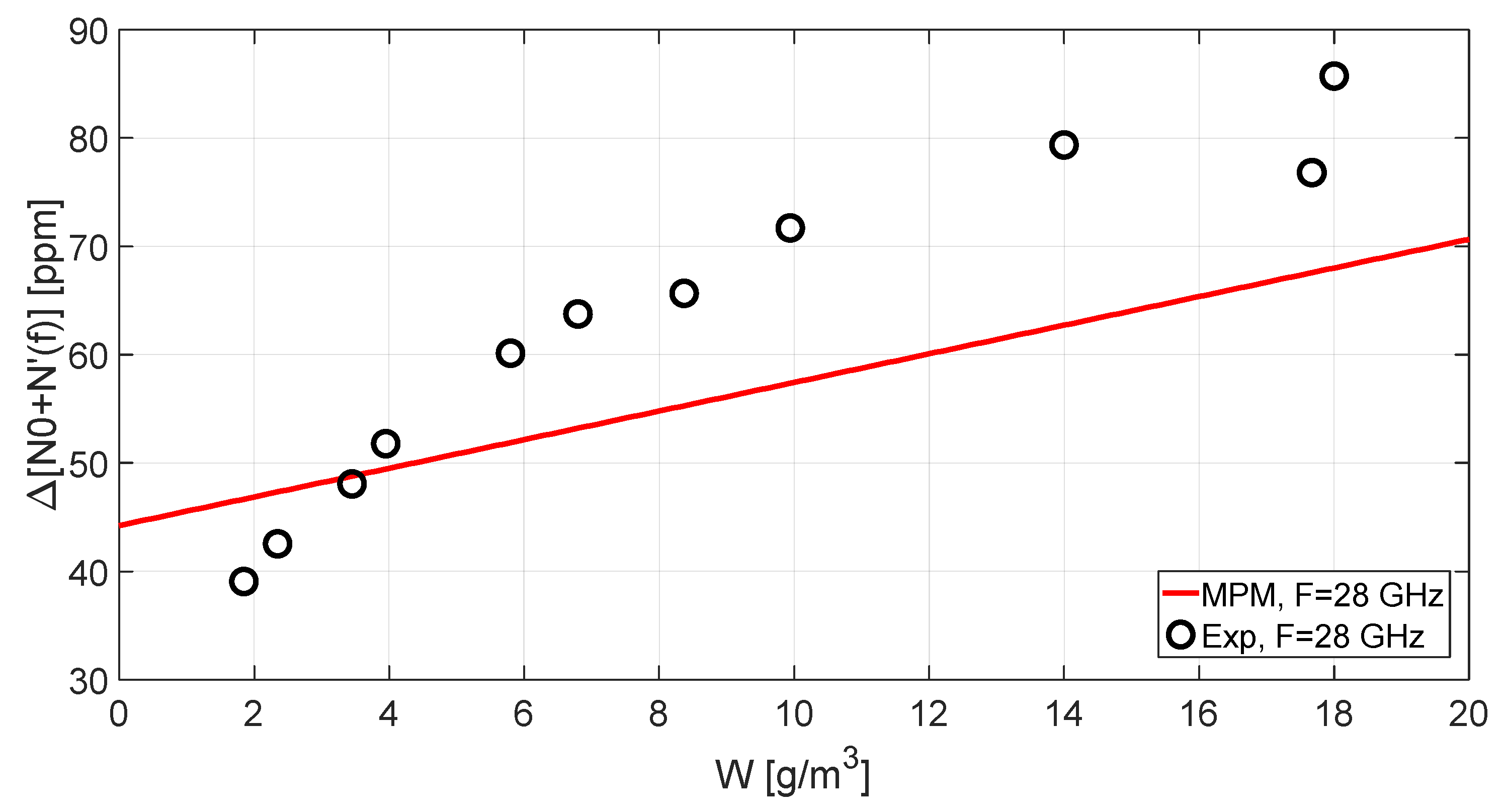

| Frequency Band | Advantages | Disadvantages |
|---|---|---|
| 28 GHz | Suffers the least path loss; Low oxygen absorption and rain attenuation. | Lightly licensed; The bandwidth is relatively small. |
| 38 GHz | Relatively less attenuation caused by oxygen absorption and rain. | Less research and applications done. |
| 60 GHz | Unlicensed bands; Large bandwidth to achieve multi-gigabit rate. | Peak point of oxygen absorption; Relatively large rain attenuation. |
| 73 GHz | Small effects of atmospheric absorption. | Large rain attenuation; Large path loss due to high frequency point. |
| Frequency [GHz] | Reference | Vapor Concentration [g/m3] | Measured Attenuation [dB/km] | Comments |
|---|---|---|---|---|
| 72.56 | [12] | 0.2 | 0.6 | |
| 210 | [13] | 0.03 | 0.4 | |
| 240 | [14] | 3 | 37 | |
| 320 | [15] | 30 | 79.8 | Artificial fog was created by a thermal fog machine |
| Visibility[m] Measured | W[g/m3] Calculated | Measured | Measured | Measured | Calculated | Calculated |
|---|---|---|---|---|---|---|
| 1000 | 0.02 | 162.7 | 0 | 0 | 0 | 0 |
| 8.5 | 1.85 | 115.4 | 47.3 | 1.3 | 39.0698 | 2.44 |
| 6.8 | 2.35 | 111.2 | 51.5 | 1.4 | 42.539 | 2.66 |
| 4.6 | 3.45 | 104.5 | 58.2 | 1.6 | 48.0732 | 3.01 |
| 3.9 | 3.95 | 100 | 62.7 | 1.7 | 51.7902 | 3.24 |
| 2.7 | 5.8 | 89.9 | 72.8 | 2 | 60.1328 | 3.76 |
| 2.3 | 6.8 | 85.5 | 77.2 | 2.1 | 63.7672 | 3.99 |
| 1.9 | 8.37 | 83.2 | 79.5 | 2.2 | 65.667 | 4.11 |
| 1.6 | 9.94 | 75.9 | 86.8 | 2.4 | 71.6968 | 4.49 |
| 1.1 | 14 | 66.6 | 96.1 | 2.7 | 79.3786 | 4.97 |
| 0.91 | 17.67 | 69.7 | 93 | 2.6 | 76.818 | 4.81 |
| 0.9 | 18 | 58.9 | 103.8 | 2.9 | 85.7388 | 5.37 |
© 2020 by the authors. Licensee MDPI, Basel, Switzerland. This article is an open access article distributed under the terms and conditions of the Creative Commons Attribution (CC BY) license (http://creativecommons.org/licenses/by/4.0/).
Share and Cite
Etinger, A.; Golovachev, Y.; Shoshanim, O.; Pinhasi, G.A.; Pinhasi, Y. Experimental Study of Fog and Suspended Water Effects on the 5G Millimeter Wave Communication Channel. Electronics 2020, 9, 720. https://doi.org/10.3390/electronics9050720
Etinger A, Golovachev Y, Shoshanim O, Pinhasi GA, Pinhasi Y. Experimental Study of Fog and Suspended Water Effects on the 5G Millimeter Wave Communication Channel. Electronics. 2020; 9(5):720. https://doi.org/10.3390/electronics9050720
Chicago/Turabian StyleEtinger, Ariel, Yosef Golovachev, Ofir Shoshanim, Gad A. Pinhasi, and Yosef Pinhasi. 2020. "Experimental Study of Fog and Suspended Water Effects on the 5G Millimeter Wave Communication Channel" Electronics 9, no. 5: 720. https://doi.org/10.3390/electronics9050720
APA StyleEtinger, A., Golovachev, Y., Shoshanim, O., Pinhasi, G. A., & Pinhasi, Y. (2020). Experimental Study of Fog and Suspended Water Effects on the 5G Millimeter Wave Communication Channel. Electronics, 9(5), 720. https://doi.org/10.3390/electronics9050720








